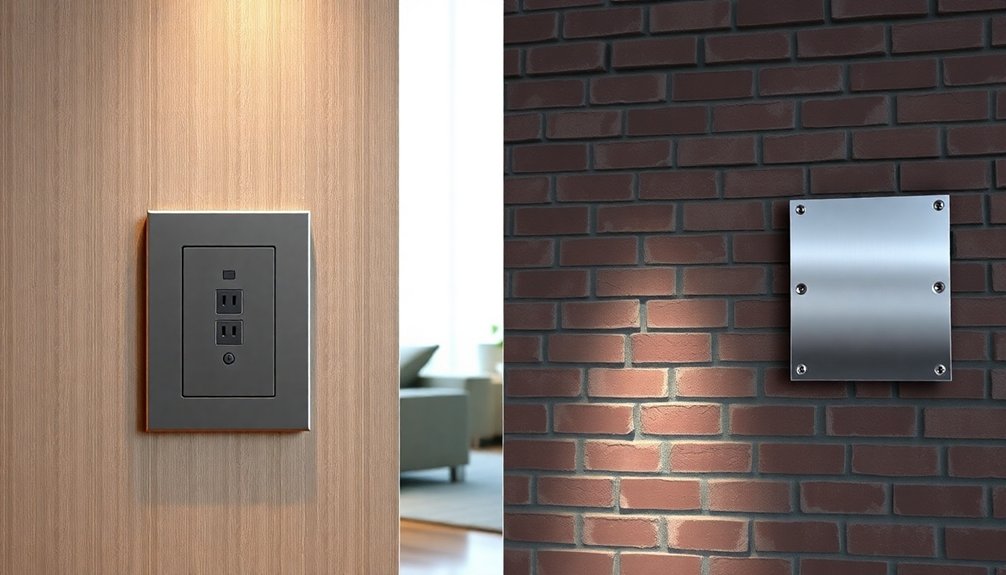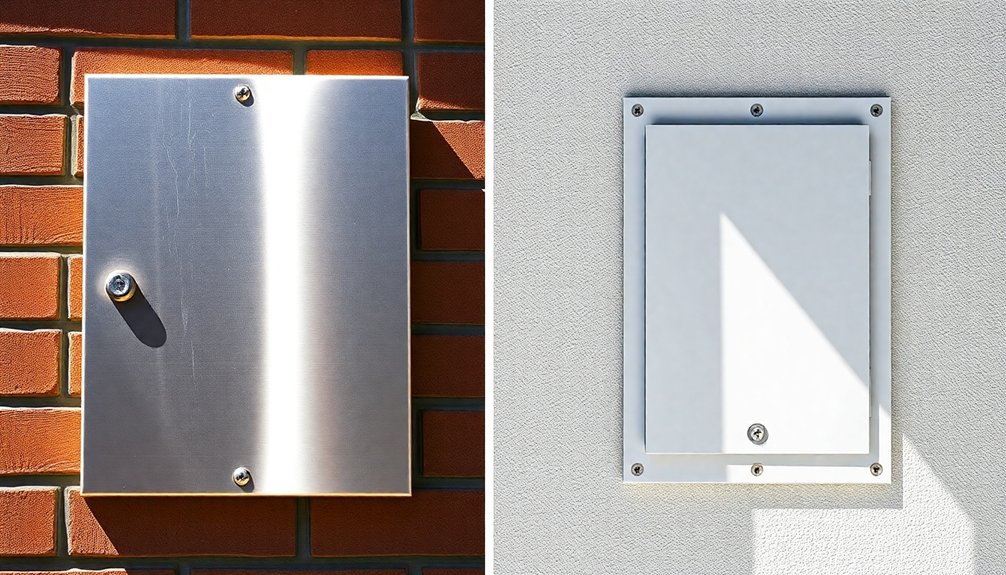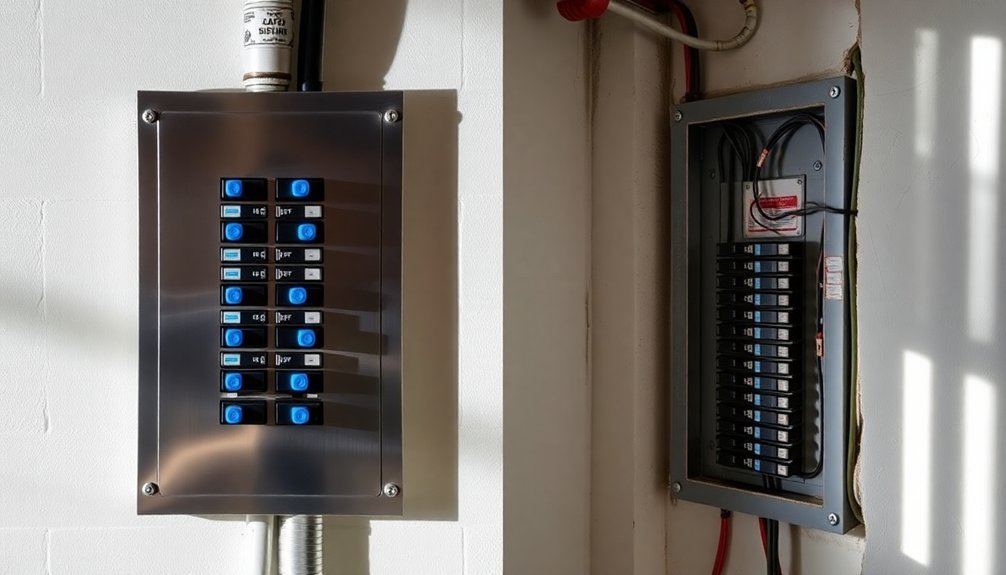When choosing between external and in-wall service panels, external panels typically save you more money upfront due to easier installation and lower labor costs. They allow for quicker maintenance, reducing long-term expenses. However, in-wall panels may offer better longevity and energy efficiency, benefiting certain home setups. Consider the trade-offs regarding installation ease versus hidden maintenance costs. Understanding these factors can help you make a more informed decision on which option fits your needs best.
Overview of Power Panel Options
When considering power panel options, it’s essential to weigh the benefits of both exterior and in-wall installations.
External panels are designed for durability, serving as the first point of entry for electrical systems into a building, while in-wall panels provide a discreet appearance.
External panels offer durability and accessibility, while in-wall panels enhance aesthetics with a discreet design.
You’ll find that licensed electricians usually prefer external panels for faster and easier installation and maintenance, as they offer better accessibility.
However, in-wall panels can enhance aesthetics and security by hiding the components from view.
While outdoor panels typically last around 30 years, indoor versions can extend to 40 years.
Efficiency varies, as external panels allow for quicker troubleshooting, but in-wall circuits may provide shorter wire runs, enhancing efficiency within the system. Additionally, using personal finance tools for investment tracking can help homeowners make informed decisions about electrical system upgrades, thereby optimizing their financial investments in home improvements.
Exterior Power Panels
Exterior power panels are vital components of a building’s electrical system, designed to endure harsh weather conditions while providing reliable power entry. Typically made from durable materials like metal or plastic, these panels suit both residential and commercial applications.
They serve as the first point of entry for electrical service, making installation straightforward for electricians and facilitating maintenance due to their accessibility. Generally, larger panels are more cost-effective for homes or commercial buildings with higher electrical loads.
With a lifespan averaging 30 years, they may experience wear from environmental exposure. Compliance with the National Electrical Code (NEC) is essential; seeking expert advice guarantees safety standards are met during installation and ongoing maintenance. Additionally, ensuring that your electrical system is regularly inspected can help enhance financial organization and prevent costly repairs in the long run.
In-Wall Power Panels

In-wall power panels offer a discreet and aesthetically appealing alternative to traditional exterior panels, especially in residential settings. These panels are typically installed in locations like closets or utility rooms, efficiently distributing power for homes with lower electrical loads.
In-wall power panels provide a sleek and efficient solution for residential electrical distribution, ideal for discreet installations in closets or utility rooms.
- They promote better overall efficiency through shorter wire runs.
- Installation requires skilled labor, cutting into drywall, and adhering to safety regulations.
- Compliance with the National Electrical Code (NEC) is essential during installation to guarantee safety and standards.
While in-wall panels can last up to 40 years, their hidden nature complicates maintenance compared to more accessible exterior options. Understanding these factors will help you decide if an in-wall electrical panel is suitable for your home. Additionally, budgeting for installation costs and ongoing maintenance can significantly contribute to long-term financial goals and enhance your overall financial planning.
Installation and Accessibility
Although both exterior and in-wall service panels serve the same fundamental purpose, their installation and accessibility differ considerably.
Installing exterior electrical panels is generally quicker and easier, often resulting in lower labor costs. In contrast, in-wall panels require cutting into drywall and may need structural adjustments, which increases installation complexity and costs.
Accessibility also plays a vital role; exterior panels allow straightforward maintenance and repairs, saving you money on potential service calls. In-wall panels, while discreet, can lead to higher expenses due to the difficulty of accessing hidden components. Additionally, the choice of panel can impact financial management as different installation methods can lead to varying long-term costs.
Ultimately, your choice impacts not just the initial installation costs but also long-term savings, as external panels may require replacement sooner than their in-wall counterparts.
Durability and Protection

When considering durability and protection, it’s essential to understand how external and in-wall service panels respond to environmental challenges.
External panels, built to withstand harsh weather, typically have a shorter lifespan due to exposure, while in-wall panels benefit from their sheltered location, offering enhanced longevity.
This comparison not only highlights the weather resistance of each type but also their material durability, which directly impacts their long-term performance. Additionally, choosing products from brands that prioritize ethical manufacturing practices can further enhance the sustainability and durability of your selections.
Weather Resistance Comparison
While external power panels are engineered to endure harsh weather conditions, in-wall panels benefit from their protected indoor environment. This distinction impacts their durability and maintenance needs in your electrical system.
- External panels are made from tough materials like metal or plastic, designed for outdoor electrical applications.
- Continuous exposure to elements can cause wear and tear on circuit breakers and other components within outdoor service panels.
- In-wall panels, though aesthetically pleasing, may complicate maintenance due to their concealed nature.
Both options provide substantial durability, with external panels lasting around 30 years and in-wall panels up to 40 years.
Ultimately, your choice should consider the environment and maintenance preferences for your service panel.
Longevity of Materials
The longevity of service panels heavily depends on the materials used in their construction and their exposure to environmental factors.
Exterior power panels, often made of metal or plastic, can endure harsh weather but typically last around 30 years. In contrast, in-wall panels, shielded from environmental elements, can last up to 40 years, enhancing their durability.
However, exterior panels may require more frequent maintenance due to exposure to rain, snow, and temperature extremes.
Both types must comply with the National Electrical Code (NEC) to guarantee safety and longevity.
Ultimately, the quality of materials used in both the main panel and in-wall installations is essential for maximizing durability and minimizing long-term electrical work costs.
Efficiency and Electrical Performance
When comparing installation efficiency, exterior panels offer easier access for maintenance, potentially streamlining repairs.
In contrast, in-wall panels may enhance performance by minimizing circuit runs, which can reduce energy loss.
Evaluating long-term performance, you’ll find that exterior panels might better withstand demanding conditions, while the accessibility of in-wall options could lead to higher costs if maintenance is needed. Additionally, understanding investment diversification can help homeowners make informed choices about which panel type best suits their energy efficiency needs.
Installation Efficiency Comparison
Although installation efficiency varies between exterior and in-wall service panels, exterior panels generally offer faster and simpler installation due to their accessibility.
Electricians can complete jobs more efficiently without the need for cutting drywall or managing complex wire runs. While in-wall panels might provide improved energy efficiency through shorter wire runs, their installation complexity often leads to higher labor costs.
- Exterior panels typically require less time and effort to install.
- Maintenance efficiency is greater with exterior panels, simplifying repairs and inspections.
- In-wall panels may complicate future updates or repairs due to their hidden nature.
Ultimately, choosing the right panel involves weighing installation efficiency against long-term benefits and maintenance considerations.
Long-Term Performance Analysis
Choosing between exterior and in-wall service panels also involves considering long-term performance concerning efficiency and electrical output.
Exterior panels generally last around 30 years, while in-wall panels can reach up to 40 years, benefiting from protection against environmental factors.
For commercial electrical applications with higher electrical loads, exterior panels are more suitable, as they can effectively accommodate greater power demands and guarantee reliable performance.
Conversely, in-wall panels typically feature shorter wire runs, reducing energy loss and enhancing efficiency for lower-load homes.
When upgrading an electrical system, remember that the quality of materials is essential; weather-resistant components are critical for exterior panels, while durability is key for in-wall options to provide lasting functionality.
Conclusion
When weighing external versus in-wall service panels, it’s clear that both options have their merits. However, if you’re looking to save money, consider installation costs, accessibility, and long-term efficiency. Ultimately, choosing the right panel is about striking the right balance between upfront investment and future savings. Remember, sometimes you have to spend a little to save a lot. By making an informed decision, you can guarantee your electrical system meets your needs without breaking the bank.


